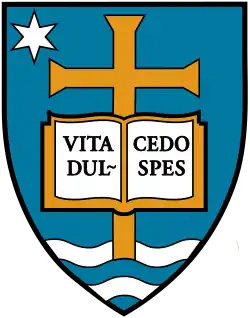Dillon Hall
Dillon Hall is one of the 32 Residence Halls on the campus of the University of Notre Dame and one of the 17 male dorms. It is located directly west of Alumni Hall, which it acquired in 1988, and is directly adjacent to South Dining Hall on the west. Dillon was built in 1931 and renovated for the 2020-2021 school year and many of the first floor rooms were converted to living and study areas. It is named after Patrick Dillon, CSC, the second president of the university. The coat of arms is taken from the Dillon family. Together with other historic structures of the university, it is on the National Register of Historic Places.[2][3]
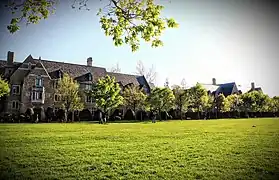
| Dillon Hall | |
|---|---|
 Arms: Argent a lion passant between three Ds Gules. | |
| Campus quad | South |
| Established | 1931 |
| Named for | Patrick Dillon |
| Colors | Red and black |
| Gender | Male |
| Rector | Michael Semanek |
| Undergraduates | 332 |
| Postgraduates | 2 (serving as Assistant Rectors) |
| Chapel | Saint Patrick |
| Mascot | Big Red |
| Interhall sports | Baseball, basketball, bowling, cross country, dodgeball, football, golf, hockey, lacrosse, racquetball, soccer, table tennis, tennis, volleyball |
| Charities | Hannah and Friends |
| Major events | Milkshake Mass, Stache Bash |
| Website | http://www.nd.edu/~dillon/ |
Dillon Hall | |
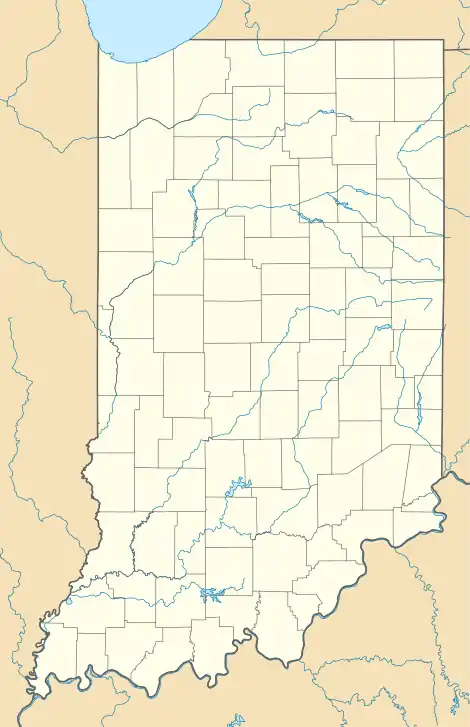 | |
| Location | Notre Dame, Indiana |
| Coordinates | 41°41′58″N 86°14′25″W |
| Built | 1931 [1] |
| Architect | Maginnis and Walsh[1] |
| Architectural style | Collegiate Gothic |
| Part of | University of Notre Dame: Main and South Quadrangles (ID78000053) |
| Added to NRHP | May 23, 1978 |
History
Construction of Dillon and Alumni was part of an extensive building program that started in the mid 20s and aimed at improving educational and living facilities, and increasing supply of on-campus residential facilities.[4] The two dorms were expected to cost $850,000 and add host 500 students to reduce the housing shortage and increase on-campus students to 2,600. Ground was broken on March 2, 1931 and construction was contracted to Sollitt and Sons.[5] Funds were collected through the Alumni Association and a $250,000 gift from the General Education Board.[6] An additional $52,000 came from the 1925 Rose Bowl.[7]
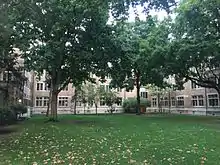
Both halls were designed in 1931 by architects Charles Donagh Maginnis and Timothy Walsh in Collegiate Gothic style. The Maginnis & Walsh was known at the time for its innovative and refined gothic design of churches and campuses in Boston, and was behind the campus architecture of Boston College and the Basilica of the National Shrine of the Immaculate Conception.[8] The architectural style of both Dillon and Alumni was in line with the previous gothic building on campus by Kervick and Fagan such as Morrissey, with local yellow brick with limestone trimmings, adorned with stone carvings on the facade and the interiors. The exterior features carvings of saints and athletes. The building is decorated with four statues by Rev. John J. Bednar, CSC, depicting St. Jerome and St. Augustine (west court), Cardinal Newman (above the southwest entrance), and St. Patrick (south wall), and a statue of Commodore Barry (located in the west court) by Hungarian sculptor Eugene Kormendi, who was sculptor in residence at Notre Dame.[9][10][11] Dillon's chapel is dedicated to St. Patrick, namesake of Patrick Dillon, and a side altar is dedicated to St. Olaf, in honor of Knute Rockne, of Norwegian ancestry, who had passed just before the construction of the hall.[12] When the halls opened in early November 1931 and three hundred freshmen moved in, the Dillon featured some of the latest technologies of the time, such as electric elevators, extension phones, buzzers, and slots for used razors.[13] The first rector was Rev. Patrick Haggerty, class of 1916.[14]
The dormitory was named after Fr. Patrick Dillon, a Notre Dame graduate who was only 33 years old in 1865 when he was named the University's second president. This continued a long tradition of naming residence halls after previous presidents. Additionally, the hall was built one hundred year after his birth.[15] He was considered lenient in disciplinary matters, a trait that made him popular among students but that had him removed from the administration only one year in his tenure. Since previous newest residential development of Howard Hall, Morrissey Hall, and Lyons Hall (built in 1924-1927) had previously been known as "Gold Coast" because of their refined architecture, Alumni and Dillon quickly were dubbed "Platinum Coast" both because they had improved amenities but also because of the grayer color of the architecture and decoration.[16][17][18]
During World War II, Dillon and Alumni housed officers for the V-12 Navy College Training Program.[19]
In 1965, together with Farley and Alumni, it was the first dorm to try the "stay-hall" system, in which residents could stay all four years in the same hall rather than being divided by class as they were up until the 1960s.[20]
Past rectors include Mark L. Poorman and Daniel R. Jenky, who later was rector of the Basilica of the Sacred Heart and Bishop of the Diocese of Peoria.[21]
Traditions
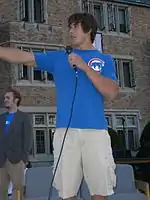
Dillon's signature event of every year was formerly the Dillon Hall Pep Rally, hosted on South Quad on the Thursday preceding the first home game.[22][23][24] The pep rally was a comedy/variety show performed outside of Dillon the Thursday before the first home football game of the fall.[25][26][27][28][29][30] Dillon's current signature event is Opening Day, a wiffle ball tournament between the sections of Dillon.[31] The hall gives out free food, as well as hosts games and activities in the courtyard between Dillon and South Dining Hall. Dillon's other major events are Milkshake Mass and the Big Red Dog Dance with Alumni Hall.[32] Alumni Hall is the traditional rival of Dillon.[22] The annual “Honor Morrissey” event (held in the spring) is a Dillon highlight. Every year, Dillon residents host a bonfire on the South Quad to pay homage to Morrissey residents. While Morrissey residents seldom attend, it is a gesture that has been honored from generation to generation of Dillon residents. It is the one time of the year that Morrissey grants the rights to play Weezer.
Notable residents
- Victor Abiamiri
- John Burgee,[33] architect
- John Carney
- Tom Carter
- Robert Costa, journalist
- John Covington
- Patrick Creadon, filmmaker
- George Dohrmann – Pulitzer Prize winner for beat reporting in 2000[34]
- Phil Donahue,[35] media personality
- Marc Edwards
- Anthony Fasano
- D. J. Fitzpatrick
- Jim Flanigan
- Mike Golic
- Paul Hornung – the "Golden Boy," 1956 Heisman Trophy winner, number one overall draft pick in the 1957 NFL Draft, and member of four NFL Championship teams with the Green Bay Packers[36]
- Bill Laimbeer - won two NBA Championships and was named to the NBA All-Star Game four times while playing with the Detroit Pistons[36]
- Derek Landri
- Trevor Laws
- Michael Madigan,[37] politician
- John Mooney, basketball player
- Tony Peterson
- Romeo Okwara
- Regis Philbin, television personality
- Brady Quinn[38]
- Tony Rice – quarterback on the 1988 National Championship team; in 1989 he won the Johnny Unitas Golden Arm Award, finished 4th in the Heisman voting, and was named to the All-American Team[36]
- Richard Riehle '70
- John Sullivan – football player
- Manti Te'o
- Thomas W. Powers
Gallery
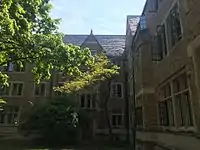 Dillon Hall side
Dillon Hall side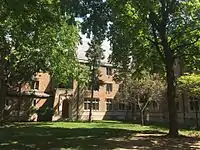 The courtyard between Dillon and Alumni
The courtyard between Dillon and Alumni Dillon Hall's main entrance
Dillon Hall's main entrance
References
- "Official Building Inventory" (PDF). Facilities Design and Operations. University of Notre Dame. October 1, 2015. Retrieved November 11, 2015.
- "Welcome to SHAARD". secure.in.gov. Retrieved May 13, 2017.
- "National Register of Historic Places Inventory -- Nomination Form" (PDF). United States Department of the Interior, National Park Service. Retrieved May 16, 2017.
- "University breaks ground for $850,00 dormitories" (PDF). The Notre Dame Alumnus. 9 (7): 240.
- "University breaks ground for $850,00 dormitories" (PDF). The Notre Dame Alumnus. 9 (7): 240.
- "University breaks ground for $850,00 dormitories" (PDF). The Notre Dame Alumnus. 9 (7): 240.
- Dufresne, Chris "When they were riding high". Los Angeles Times, October 2, 2007
- "Maginnis & Walsh | Biographical Dictionary of Architects in Canada". dictionaryofarchitectsincanada.org. Retrieved June 4, 2020.
- "Campus Statue Project". Notre Dame Archives News & Notes. June 17, 2011. Retrieved November 5, 2019.
- "Eugene Kormendi". Smithsonian American Art Museum. Retrieved November 5, 2019.
- Lyman, William. "Campus Statues - Baffle & Bore" (PDF). The Notre Dame Scholastic. 89 (20): 14. Retrieved November 6, 2019.
- Lindquist, Sherry C. M. (January 1, 1970). "Memorializing Knute Rockne at the University of Notre Dame | Sherry Lindquist". Winterthur Portfolio. Academia.edu. 46 (1): 1–24. doi:10.1086/665045. S2CID 146612474. Retrieved December 23, 2015.
- "Alumni and Dillon Halls Opened to Students" (PDF). Notre Dame Alumnus. 10 (2). November 1931. Retrieved June 4, 2020.
- "Few Changes In Province's Triennial Chapter" (PDF). Notre Dame Alumnus. 10 (1). October 1931. Retrieved June 4, 2020.
- "University breaks ground for $850,00 dormitories" (PDF). The Notre Dame Alumnus. 9 (7): 240.
- "Know Thy Notre Dame" (PDF). Scholastic. 86 (9): 10. January 25, 1946. Retrieved June 6, 2020.
- Scholastic (PDF). 66 (4). October 14, 1932 http://archives.nd.edu/Scholastic/VOL_0066/VOL_0066_ISSUE_0004.pdf. Retrieved June 6, 2020.
{{cite journal}}: Missing or empty|title=(help) - "ND Expansion: and still it grows" (PDF). Scholastic. 97 (11). January 13, 1956. Retrieved June 6, 2020.
- "Directory of Students 1943-1944" (PDF). Retrieved June 4, 2020.
- Blantz, Thomas E. (2020). The University of Notre Dame : a history. [Notre Dame, Indiana]. p. 423. ISBN 978-0-268-10824-3. OCLC 1182853710.
{{cite book}}: CS1 maint: location missing publisher (link) - "Staff List". Heart of Peoria Catholic Community. Retrieved June 6, 2020.
- Notre Dame game day : getting there, getting in, and getting in the spirit. Diamond Communications, Inc. October 23, 2001. p. 128. ISBN 9781461733973.
- "Dillon pep rally a rousing success". Irish Rover. September 14, 2012. Retrieved June 6, 2020.
- Tucker, Todd; Holtz, Lou (2000). Notre Dame Game Day: Getting There, Getting In, and Getting in the Spirit - Todd Tucker, Lou Holtz. Rowman & Littlefield. ISBN 9781888698305. Retrieved December 23, 2015 – via Google Books.
- Irish Traditions: Dillon Hall Pep Rally. "Dillon Hall Pep Rally - Notre Dame Traditions". UHND.com. Retrieved December 23, 2015.
- "Dillon is ready to rally". The Observer. September 2012. Retrieved December 23, 2015.
- Flatley, Andrew (September 14, 2012). "Irish Rover". Irish Rover. Retrieved December 23, 2015.
- "ND pep rallies changing locations this football season". Wndu.com. August 14, 2009. Archived from the original on March 10, 2014. Retrieved December 23, 2015.
- "News and Feature Photos from Friday September 2, 2011". South Bend Tribune.
- Collins, Michael. "Irish Game Day: A Guide to Events and Traditions at Notre Dame". Bleacher Report.
- "Dillon Hall to host Opening Day event // The Observer". The Observer. April 26, 2019. Retrieved June 4, 2020.
- "Dillon Hall keeps community in Baumer for year // The Observer". The Observer. August 28, 2019. Retrieved June 4, 2020.
- "Notre Dame Directory 1953-1954" (PDF). Retrieved January 31, 2019.
- "2000 Pulitzer Prize Winners".
- "Notre Dame Directory 1955-1956" (PDF). Retrieved January 31, 2019.
- "Hall Portrait: Dillon // News". Notre Dame Magazine. University of Notre Dame. March 19, 2004. Retrieved February 23, 2017.
- "Notre Dame Directory 1962-1963" (PDF). Retrieved January 31, 2019.
- Thamel, Pete (September 9, 2006). "A Student First, Then a Standout". The New York Times. Retrieved February 23, 2017.
